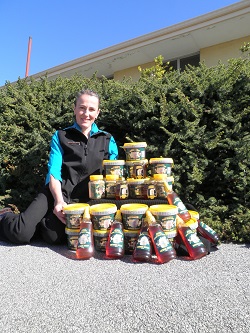|
Debbie Starr is a talented and experienced chef and also the luminary behind Swan Valley Honey.
Debbie has successfully combined her passion for cooking and experience in marketing to create and promote a tantalising range of Western Australian honey products. |
| Since starting the business she has learnt a lot about spreading the risks that come with running your own business, varying your sale points and marketing her products. Swan Valley Honey had humble beginnings as Lyle’s Busy Bee Products. The honey was distributed as part of a mobile fruit and vegetable service which was operated in the Perth metropolitan area in the 1980s by Debbie’s father, Lyle. Lyle bought raw honey direct from apiarists, packed it and sold it alongside his fruit and vegetable supplies. After Lyle retired, Debbie took over the business. The fruit and vegetable mobile service was discontinued and the business focus shifted to the wholesale of honey products to independent supermarkets. Since this change in business direction the range of Swan Valley products has considerably grown, along with the number of outlets. The processing of honey “Our preference is always for honey from unpolluted forests and wildflower regions,” Debbie said. “Western Australia is fortunate to have a clean source of honey. However, to comply with quarantine regulations, honey entering WA from the eastern states requires heat-treatment to destroy any pathogens that could endanger the local bee population.” |
 |
| Honey is filtered to remove impurities that have been spun from the wax comb along with the honey. Filtered honey appears clear while unfiltered honey may appear cloudy. The degree of filtering also has an effect on honey quality. Apart from quarantine regulations, honey may also be heated to melt the sugar crystals that sometimes cause honey to crystallise. This crystallisation does not harm the honey’s properties, but some consumers have a preference for clear honey. Once heated, the honey will remain clear for longer. Achieving the desired liquid state without destroying the honey’s sought after qualities is a balancing act between sufficient heat for the minimum elapsed time and the time it takes to cool the honey after treatment. Honey produced from different blossoms will have different sized sugar crystals and therefore different rates of crystallisation. These differences allow the apiarist and honey processor to choose honey with a known potential for less crystallisation. For the apiarist, this adds to choices of where to park the hives. |
| Labels usually do not contain information on how the honey was processed, but buying honey from Western Australian (WA) suppliers is the best way to ensure quality honey. | “Our preference is always for honey from unpolluted forests and wildflower regions" |
| Spreading the risks Swan Valley Honey comes from several apiarists working in different areas of WA to cover seasonal supplies. The apiarists deliver to Swan Valley’s processor/packer and Debbie also processes small quantities of creamed honey in her stainless steel Health Department approved honey room, before taking the product to the consumer.
“Apiarist’s seldom distribute their honey products as well as manage their bees, as it is very difficult to do both. There just isn’t enough time for a small business to be both collecting and distributing honey without employing a large number of staff.”
As always when dealing with an agricultural product, the vagaries of climate coupled with localised disasters in the form of bushfires, failed flowering, frosts and biosecurity issues are also risks.
“Sourcing the honey from both the northern and southern regions means we have insurance against local disasters, as well as a variety of different honey flavours. The northern areas give us the wildflower honeys and the southern regions around Margaret River and Albany provide the forest blossoms, jarrah, red gum and banksia.” Debbie said.
Diversifying your range of products is also essential. If there is a problem with the supply of one product, then the business can rely on other products while the problem is rectified.
Diversity can also help with markets. Producing products that appeal to a wide range of market sectors can reduce the risk if one sector changes their buying preference.
Part 2, includes: - Products
- Varying your point of sale |
News Category



